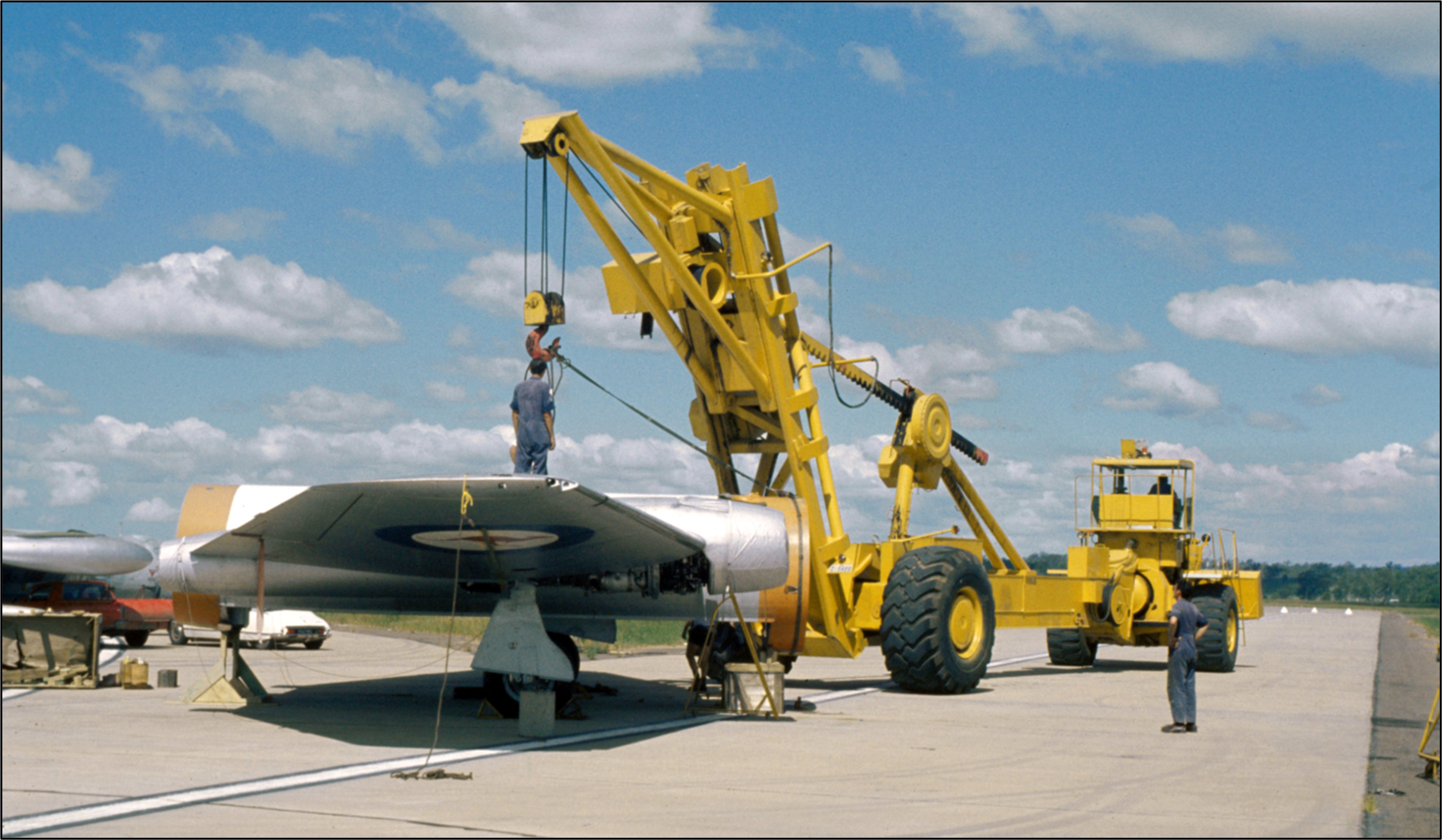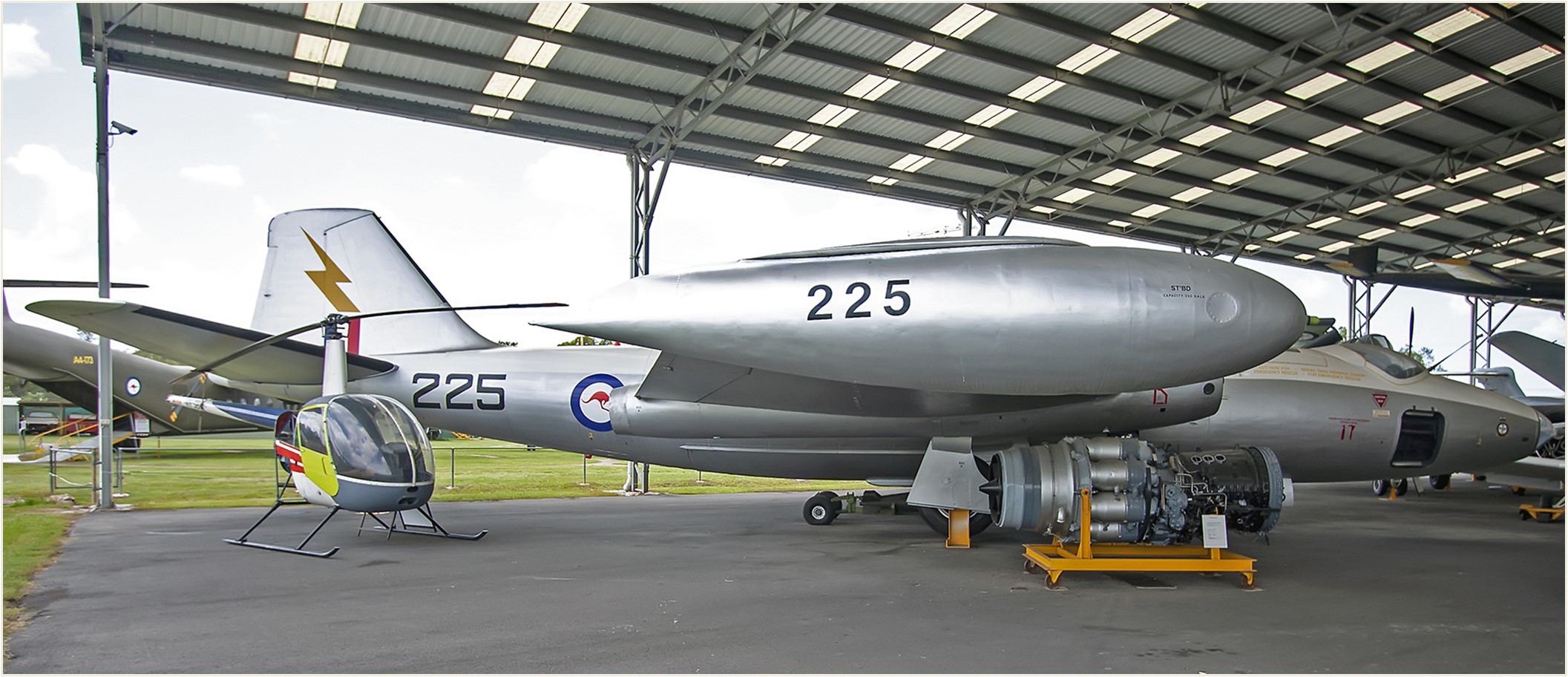|
||||
|
Privacy Policy | Editorial Policy | Profit Policy | Join the Association | List of Members | Contact us | Index | Links |
||||
|
Back Go to page: 1 2 3 4 5 6 7 8 9 10 11 12 13 14 15 16 17 18 19 20 Forward |
||||
|
|
||||
|
Queensland Air Museum’s first aeroplane.
A84-225 - Canberra Mk 20 50 years on
Ron Cuskelly QAM Historian and founding member
The Queensland Air Museum can trace its roots back to 15 September 1970 when Brian Eggleton, the Brisbane manager of the global travel agency Thomas Cook, hosted a meeting at his Clayfield, Brisbane residence with a view to forming a local chapter of the Aviation Historical Society of Australia (AHSA). Attendees were already members of the federal AHSA so the outcome was a foregone conclusion.
|
||||
|
|
||||
|
Probably nobody at this meeting anticipated the events that would be set in train, but for the time being, the members were content to hold regular monthly meetings with guest speakers, film screenings and aircraft slideshows while fostering the recording of aviation history in the Society’s journal. The turning point was the publication in the Brisbane Courier-Mail of a notice that the Department of Supply was calling tenders for the purchase and removal of seventeen Canberra aircraft from RAAF Base Amberley with a closing date of 3 July 1973.
This was a crossroads for the small group of approximately forty members. Was it enough to record history or should they also physically preserve history? Clearly it was “put up or shut up” time.
Initially, the group operated under the cumbersome handle of the Aviation Historical Society of Australia Limited (Queensland Branch) Aviation Museum Group. Therefore, it’s hardly surprising that the group later embraced the minimalist approach by adopting the name Queensland Air Museum. It seems that even the word “aviation” was considered too lengthy! Henceforth, this narrative will refer to the group as QAM although this name was not formally adopted until May 1974.
Wisely realising that they were not yet prepared for ownership of an aeroplane, it was decided to submit a nominal tender of one dollar for any one of the aircraft with the intention of “keeping their name on the books” for when the next batch of Canberras came up. Not unexpectedly, this tender was declined, however, the Department of Supply did come back with an invitation to make a best offer for Canberra A84-223. After due consideration of their financial circumstances, it was determined that their best offer would be $255. This too was declined. By November of 1973, the disposal of the seventeen Canberras was coming to a conclusion and communications from the Department of Supply were now elevated to the urgency of a telegram with an invitation to tender for Canberra A84-225 in the amount of $1,360 ($14,000 in today’s money). It is understood that this amount was determined by a withdrawn tender from private collector Les Arthur of Toowoomba.
Probably as a result of a quick ring around, three members agreed to make the funds available as loans and the deal was done. On 21 November 1973 the fledgling museum became the owners of Canberra A84-225 — and the obligation to remove it from the base within twenty-eight days. To assist with the dismantling, the RAAF had assigned an NCO as an adviser although it is suspected that his main task was to ensure that nobody died. The gentleman’s name was Overall, a fact that is etched into the memory of those present because he had an embroidered patch on his overalls attesting to the fact that his name was indeed Overall. One of the volunteers plotted to turn up the next day wearing a shirt labelled “Shirt”!
One crucial piece of advice to come from the RAAF was that QAM consider a previously untried method of transporting a Canberra. It was suggested that they remove the forward and rear fuselage at the existing transport joints and load the entire wing, with centre section, engines and extended main undercarriage, lengthwise on a semi-trailer. This eliminated the need to remove the engines and separate the wings from the fuselage. This necessitated cutting a small access panel at each wing root so that one of the wing bolts could be removed and replaced with a lifting shackle.
|
||||
|
|
||||
|
Probably because all the other Canberras had to be trucked greater distances, it is believed that only A84-225 was transported in such a way. It must have been successful because the process was later repeated on no fewer than three occasions as the museum roamed south-east Queensland in search of a home. However, they weren’t to know this in 1973!
It is claimed that
A84-225 was one of the first Canberras to be retired when wing cracks
were discovered, but as these cracks emerged across the fleet, aircr
Clearly the aeroplane had been used as a source of parts for when it was sold there were no seats or instruments fitted. The undercarriage actuators had also been removed and replaced with non-folding jury struts. In an attempt to preserve the cockpit canopy in open storage, the RAAF had coated it with a black latex material. This was to become a significant problem for QAM as the latex was apparently applied too thinly and it had separated into thousands of small black dots making it impossible to peel it off as intended. Tests revealed that the substance would yield to methanol but in the end it came down to a painstaking process of laboriously and carefully removing each dot with a scraper.
One inclusion on the aeroplane that was not required by the new owners was a substantial quantity of jet fuel. With the assistance of their RAAF minders, this miraculously disappeared overnight to be used by a local farmer as weed killer.
Other miracles ensued. During one work party to dismantle the aircraft, the volunteers were presented with a cardboard box marked “A84-225”. This was found to contain all the missing instruments. On another occasion, the volunteers arrived on site to find that the aircraft was now fitted with two ejection seats. These seats soon came to the attention of an inspecting officer who remarked; “I thought these aircraft were sold without seats. I shall have to investigate this.” QAM heard no more about it so evidently the seats had been bestowed by a higher authority.
With the dismantling progressing satisfactorily, there remained one problem. Where to put it? QAM’s founders weren’t totally naïve as they did have a contingency offer from one of the members to store the aircraft on his farm at Boonah but this was not the prominent display venue QAM had in mind. It had been hoped that the Canberra could be displayed at an airport but the owners of Australia’s airports were well into cost recovery mode and aspiring aviation museums were deemed unworthy of special financial consideration. Accordingly, QAM President, Richard Hitchins, approached Alan Underwood who was the aviation writer at Brisbane’s Courier-Mail, as a result of which the 29 December 1973 edition screamed a banner headline immediately under the paper’s masthead; A Bomber with nowhere to go.
Although presented to the public as the museum’s embarrassment, the publicity did produce immediate results with several offers of sites. At this time the Hunter family, who once held the waste collection contract for Brisbane, were developing a museum of horse-drawn vehicles on their property in the southern Brisbane suburb of Kuraby and they offered a prominent position at their Pioneer Valley Park with exposure to a main road. This offer was gratefully accepted. With the deadline for removing the aircraft from Amberley approaching, came the rain. History records this rain as the “Australia Day Floods”. Much of Brisbane was flooded and roads between Amberley and Brisbane were cut. Indeed the floodwaters came close to the disused taxiway on which A84-225 was parked.
Following an appeal to Canberra (the one in ACT) an extension to 12 February was granted. To arrange road transport, QAM had gone cap in hand to heavy haulage specialists Brambles and they generously offered to assist. To save on the cost of positioning a crane to Amberley they had also gone cap in hand to the RAAF and it was agreed that their resident LeTourneau crash crane could be used to load the trucks. This diesel/electric behemoth was designed to lift, or push, disabled aircraft off runways. An onboard diesel engine coupled to a generator supplied electrical power to a motor in each wheel and to every other service — including the brakes. It was nervously hoped that the beast would have the finesse to lift an aeroplane destined for a museum. Indeed it lifted the Canberra with ease but while the aircraft was lowered to the ground to adjust the slings, the generator expired with a mighty bang and a shower of sparks. Clearly its day was done.
With daylight fading, the legendary Brambles foreman, Rex Murphy, rang head office in Brisbane to summon their latest crane which they reverently referred to as Tojo. In due course Tojo arrived on site having negotiated peak hour traffic only to be confronted with an unanticipated degree of difficulty. Gaining access to the Canberra was complicated by the presence of the expired LeTourneau crane which couldn’t even be towed out of the way because the electric brakes could not be released. Nevertheless, loading proceeded without further difficulty in the dark and the aircraft was ready to depart for Kuraby at first light on 13 February.
The rest of the operation went without a hitch and A84-225 was eventually reassembled at Kuraby and made presentable for the inauguration of the Queensland Air Museum on 2 June 1974 with Air Commodore C.H. Spurgeon officiating — in yet another torrential downpour!
Sadly, Pioneer Valley Park fell on hard times and in 1977 QAM was forced to move the Canberra again, this time to a disused orchard at Lower Nudgee near Brisbane’s Eagle Farm Airport. In 1980, QAM’s wish to be on an airport almost came true however, rather than moving to an airport, an airport was moving to QAM! The Lower Nudgee site was in the middle of the planned floodway for the new Brisbane Airport. No doubt QAM was a considerable inconvenience for the government so they relented and allowed QAM to move its aircraft (by now four in number) on to a remote corner of Eagle Farm airport. Sadly this was not the triumph that it may have appeared to be. While it was the biggest airport in the state, there was no optimism for a long-term future in an arrangement ominously described as “permissive occupancy of a temporary holding area”. Clearly the writing was on the wall.
While located on Brisbane Airport, A84-225 again made the front page of the newspapers in January 1983 when it was struck by a homemade projectile which was intended as a demonstration of what an extortionist was threatening to do to a TAA airliner. Having worn out its welcome at Brisbane Airport, QAM continued its campaign for a permanent site, ultimately accepting an invitation to relocate to Caloundra Aerodrome on the Sunshine Coast in 1986.
This was a spectacular leap of faith for QAM’s founders to move the museum 100km away from their base but even then, Caloundra was emerging as a tourism hub. Thus QAM has moved Canberra A84-225 on no fewer than four occasions, all using the same creative method. Given that the aeroplane was never intended to fly again, QAM volunteers didn’t bother to replace every bolt when the Canberra was reassembled however, after the fourth move, the novelty was beginning to wear off, so additional bolts were replaced in the hope of making another move less likely. The members’ loans which financed the purchase of the Canberra were later converted to donations.
Addendum: As we approach 2024, we are keenly aware of the importance of the QAM 50th anniversary milestone. Events and major projects throughout 2024 are in the planning phase, including a gala evening on Saturday, June 1st and a ceremony beneath the wings of A84-225 at 2pm on Sunday 2nd June - the exact time and day of the inauguration of what has grown to become a unique and significant enterprise.
Featured in profile in our logo, A84-225 embodies much of the essence of QAM’s story. A commitment has been made to refurbish our Canberra in anticipation of the June 2nd ceremony. Naturally, this will be a costly project, demanding materials and volunteer skills and labour, and any assistance that may be offered in tax-deductible gifts or in kind by those who believe in what we are trying to achieve will be most gratefully received.
Donations may be made through our website (www.qldair.museum).
As an all-volunteer, not-for-profit incorporation – a people’s aviation museum – QAM is proud of its heritage and committed to its future.
Garry Hills QAM President
|
||||
|
|
||||
|
Back Go to page: 1 2 3 4 5 6 7 8 9 10 11 12 13 14 15 16 17 18 19 20 Forward |
||||

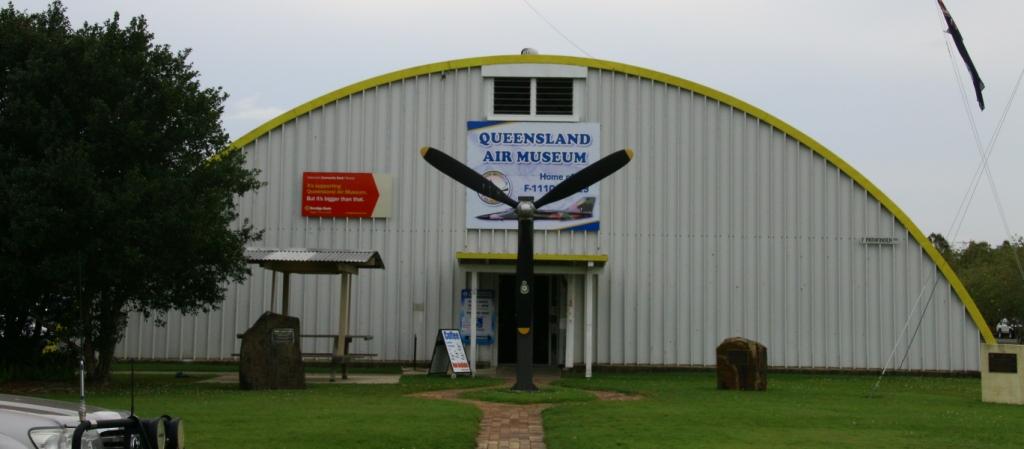
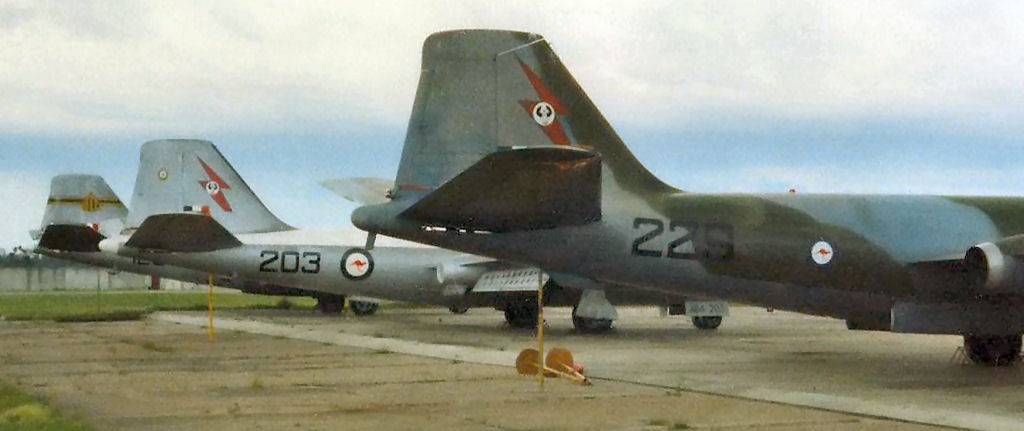
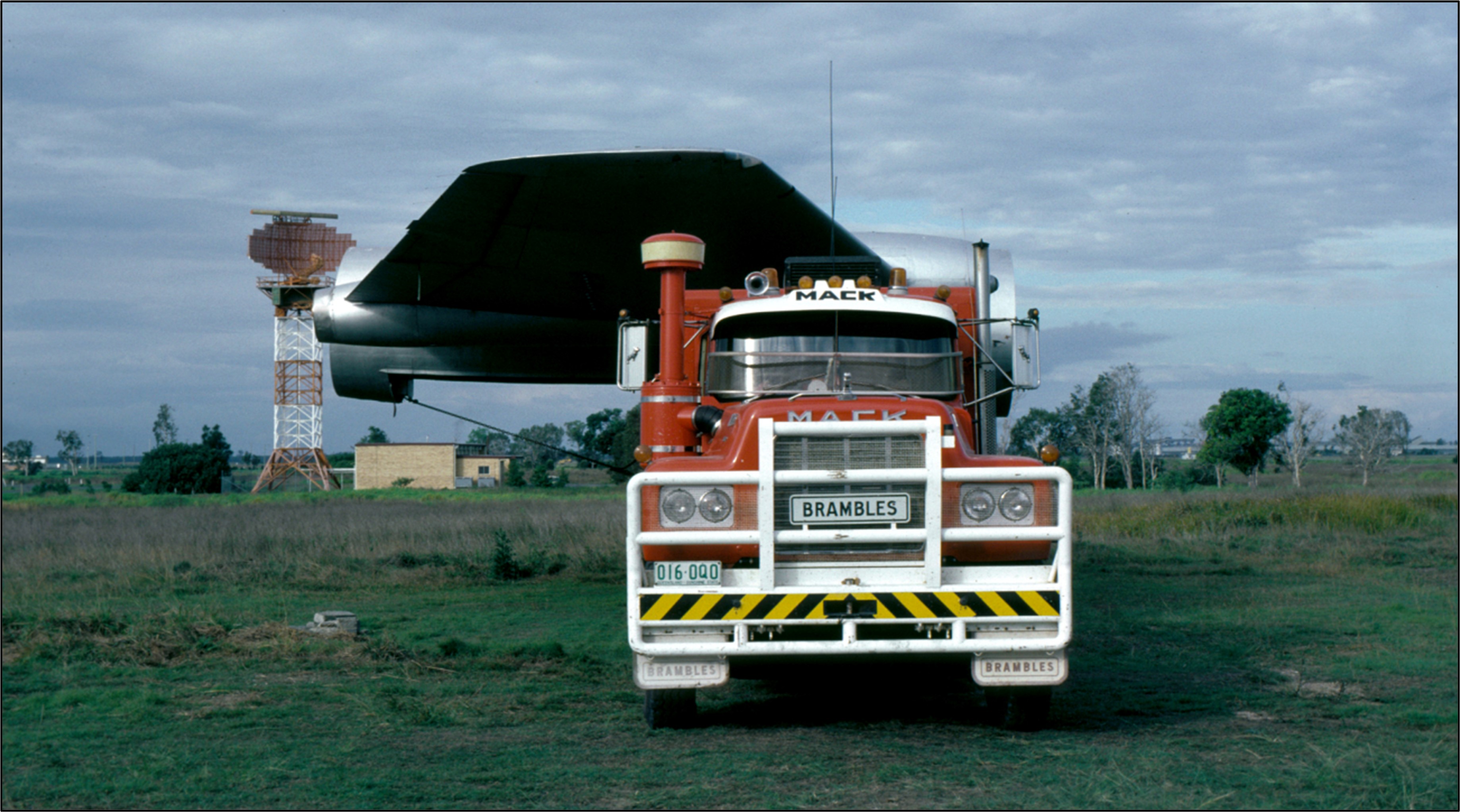
 aft
remained in service with cracks worse than those on A84-225. Towards the
end of its RAAF service, A84-225 was placarded to the effect that the
airframe was limited to +2G except in an emergency. This probably led to
the aeroplane being relegated to target towing duties in which role it
was marked with orange bands around the fuselage fore and aft. The
aircraft retained these markings until it was finally retired in January
1971.
aft
remained in service with cracks worse than those on A84-225. Towards the
end of its RAAF service, A84-225 was placarded to the effect that the
airframe was limited to +2G except in an emergency. This probably led to
the aeroplane being relegated to target towing duties in which role it
was marked with orange bands around the fuselage fore and aft. The
aircraft retained these markings until it was finally retired in January
1971. 